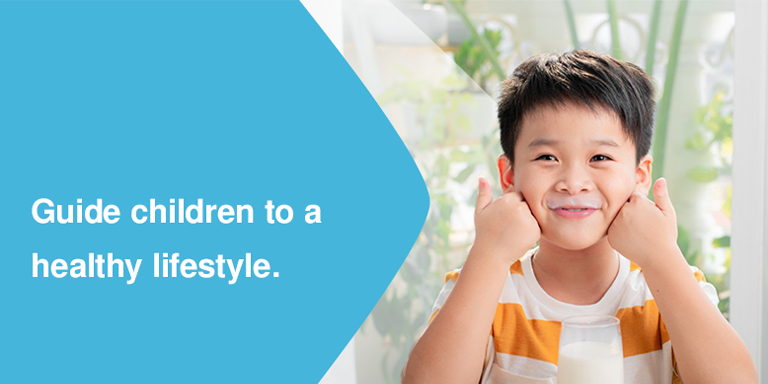7 Healthy Habits
What does it mean to properly train a child on what they should eat? Is there a standard equation or combination of food they should eat to ensure that they are getting the proper nutrition for their growing bodies? Understandably, every parent tries to give their children healthy food so they grow up strong, fit, and healthy. However, parents often find it challenging to serve nutritious food that children will easily like.
To address, Nestlé Wellness Campus has developed a program to help parents establish healthier eating, drinking, and lifestyle habits for children:
1. Choose Nutritious and Varied Options

The best way to prevent malnutrition is by having a healthy, balanced diet. Eating a varied, nutrient-rich diet based on different food groups will not only allow the body to get the nutrients needed for normal growth and development but has also been shown to have significant health benefits for all ages. A meta-analysis in adults showed that higher consumption of vegetables and fruit is associated with a lower risk of all-cause mortality, particularly cardiovascular mortality.1
What are some tested strategies to enable this habit?
- Consider food preferences – Instill positive behaviors around food choice at an early age. By doing so, parents can not only help give their children the best possible start to life but can also help their children avoid developing poor healthy eating habits that have been shown to carry into adulthood.2-4
- Offer healthy foods at each meal – Children benefit from regular exposure to a variety of vegetables and fruits. Parents can achieve this by regularly including them at mealtimes, increasing their portions or even serving them as part of snacks.5
- Provide a positive environment at home – Children are influenced by their parents’ own eating habits. Providing parents with education about good nutrition could therefore have a positive impact on children’s diets. Encouraging parents to act as positive role models by consuming a variety of healthy, nutrient-dense foods at home can also play a significant role in children’s acceptance of fruits, vegetables and other healthy foods.6
- Involve children during food preparation – Inviting children to choose the ingredients they eat and be part of the meal preparation process has been shown to have a positive impact on the quality of their diet.7
- Improve food preferences through repeated exposures – Repeated exposure to foods have been suggested as potential techniques for helping to overcome children’s tendency to be picky eaters. Exposing children to healthy foods 8-15 times can improve their preference for that food.8
- Avoid food restriction and pressure at mealtime – Several studies have indicated that restricting access to particular foods increases rather than decreases preference and forcing a child to eat a certain food can decrease the liking for that food. 9
2. Manage Portions
Eat the correct portions for age to receive the right amount of nutrition from carbohydrates, protein, fruits, and vegetables. Controlling intake of less nutritious foods high in visible sugars, salt, and fats will also help avoid non-communicable diseases such as obesity and cardiovascular diseases.
What are some tested strategies to enable this habit?
- Serve vegetables and fruits as side dishes – Multiple studies have explored the possibility of increasing the intake of healthy foods by increasing the serving size of side dishes that contain fruit and vegetables. Their intake can also be increased by serving them as snacks.10-12
- Serve low-energy-dense foods as a first course – Serving low-energy-dense foods, like soups and vegetables, as a first course is also an effective strategy to reduce intake of a more energy-dense main meal and increase vegetable consumption.
- Allow children to serve themselves – Some studies have shown that when given the chance to serve themselves, children consumed 25% less of a large main course, compared to when they were served by an adult.13
- Serve children food on child-size dishware – Providing food on larger plates or containers may result in increased energy intake in children. In fact, a study has found that children served themselves more total calories when using adult-sized dishware.14 Furthermore, if children are shown a pictorial guide of what is acceptable, they could be less likely to eat larger portions.15
3. Choose to Drink Water and Milk

Water is essential for practically all functions of the body and is particularly important for thermoregulation, the process that allows your body to maintain its core internal temperature. A water intake that balances losses and assures adequate hydration of body tissues is essential for health and life. Numerous studies from different countries show a high proportion of individuals failing to meet daily water intake recommendations.16,17 This highlights the need for interventions to promote water intake.
Milk is a beverage that provides complete protein as well as essential nutrients like calcium and phosphorus. Milk has also been found to be a good vehicle for the delivery of micronutrients, like iron, vitamin C, and zinc.18 Although the Filipino food pyramid recommends intake of at least one serving of dairy products per day19, most Filipinos have low intakes which may have long term effects not only in the anthropometric measurements but also in their psychomotor abilities.20-22
What are some tested strategies to enable this habit?
- Teach the importance of drinking water and milk – Educating children and parents about what constitutes a healthy drink can be effective to promote hydration and limit sugar sweetened beverage (SSB) consumption. A systematic review found that school‐based education programs, including follow‐up modules, offer opportunities for implementing effective, sustainable interventions on reducing SSB consumption, with associated reductions in body weight.23
- Set as an example – Encouraging parents to act as positive role models by consuming water and milk at home can play a significant role in children’s behavior. In fact, positive parenting is correlated with decreased intake of SSBs and increased intake of water. 24
- Make water and milk drinking easier and more fun for children – Make sure children always have access to water and milk by providing water bottles or convenient ready to drink milk at home. Parents can also let children choose fun cups and to-go bottles that they will look forward to using for drinking. Finally, have kids fill out a chart of how much water and milk they are drinking. Add a sticker every time they drink and compare day to day to see how they are doing.25
4. Play Actively

Movement and physical activity have been shown to improve overall health of adults and children.26 The WHO recommends that children spend at least 60 minutes partaking in moderate-to-vigorous intensity physical activity per day.27 It is important to recognize however that children can be active in many different ways, at any time of day, and a moderate level of activity is better than no activity.
What are some tested strategies to enable this habit?
- Encourage children to play with others – Playing with others helps children build both motor and cognitive skills. Activities such as role playing, play dates and/or enrolling children in a group or club can provide opportunities for interaction among others.28,29
- Be a positive role model and encourage family activities – The home environment has an important influence on children’s sedentary behavior and physical activity from preschool age to adolescence. In particular, evidence shows that children of parents who are more active themselves and encourage their children to be active, exhibit less sedentary behaviors.30 By being positive role models, parents can encourage their children to be more active.
- Encourage indoor activities when outdoor play is not practical – In situations where encouraging outdoor play and activity is not a feasible option, parents should focus on games and activities that involve movement but can be done inside the home, with limited space.31
- Reduce passive entertainment – Time spent engaging with media devices, computers and TV, sometimes referred to as passive entertainment, is significant because it reflects a large amount of time being sedentary and inactive.32 Consider reducing screen time outside of school or work to less than 2 hours per day and remove screens like TV and tablets from children’s bedrooms.
5. Enjoy Meals Together
Family meals are considered an important positive aspect of both social family life and dietary habits. Children who have more family meals tend to have healthier diets, including increased nutrient intake from fruits, vegetables, calcium-rich foods and decreased intake of low-nutrient-dense foods and beverages.33

Family meals also provide social and psychological benefits to children. Designating time for family conversation provides children with an opportunity for social interaction and support.34 Observational, behavioral studies show mealtimes serve an important role for developing language and social skills. Studies across New Zealand, Korea and the United States have shown greater frequency of family meals is associated with fewer depressive symptoms, fewer emotional difficulties, better emotional well-being and improved mental health outcomes among teenagers who experience cyberbullying.35-37
What are some tested strategies to enable this habit?
- Create a positive home environment – Parents should create a positive environment in the home by dedicating time and making healthy choices available and accessible and avoiding pressure and restriction of foods. Studies suggest parenting practices that influence the home food environment (e.g., food availability and parental role modeling) are more effective in shaping a child’s behavior rather than those that act more directly on the child’s traits (e.g., restriction, pressure, reward, encouragement).38
- Recognize the value of breakfast – Research across the globe has indicated that children who eat breakfast are less likely to become overweight or obese. This is more pronounced when families eat breakfast together.39-41
- Avoid distraction during meals – The benefits of family meals rely on families communicating, observing, role modeling and being present at the table.42,43 When children and parents are distracted, whether by television, phones or other tasks, the benefits of family meals do not persist. Parents can set rules for mealtimes, such as no phones and no television, to reduce distraction during family meals.44
- Capitalize on mealtimes to role model healthy behaviors for children – Mealtimes provide an opportunity for parents to employ role modeling and exhibit healthy habits. Children aged 2–5 years are more likely to eat novel foods when adults eat the same food. Children who report their parents consume fruit and vegetables are also more likely to meet recommendations for fruit and vegetable consumption.
- Encourage parents to prepare, plan and cook family meals – Given time as a constraint among many families, parents and caregivers should be taught to cook simple, easy but healthy recipes. Equipping families with the skills and resources to cook meals might increase the frequency of family meals.45-47
- Involve children in cooking and food preparation – Parents can reframe food preparation as a valuable opportunity to spend time with children, contribute to lifelong skills or save money and create quality food.48,49
6. Keep Good Hygiene
Personal hygiene helps children build a strong foundation to lead a healthy life, because it protects them from microorganisms that can compromise their health. It not only prepares them to be healthy adults, but it also helps them to develop discipline when they establish a hygiene routine.50 This discipline can be applied to other aspects of their life, like their education or any extracurricular activity. It is important that parents and caregivers take time to guide them so that they practice the habit consistently. Showing them what to do and explaining why they should do it helps them to connect and appreciate their bodies.

What are some effective ways to practice this habit?
- Washing hands – Handwashing with soap is one of the most effective ways to protect and maintain good health. Washing hands involves vigorously rubbing the soap on one’s hands and between their fingers for 20 seconds to effectively eliminate microorganisms.
- Brushing teeth – Tooth brushing is one of the most efficient ways to protect oral health. It prevents teeth from decaying and prevents gums from getting periodontal disease.
- Taking a shower – Daily showers help children to avoid infections, germs and developing odors, because it helps to remove dirt from the body.
7. Care for the Planet
The quality of the environment largely determines the quality of physical health and well-being, and solid waste management is certainly a pressing concern in environmental health.
As the Kasambuhay for the Environment, Nestlé strives to reach its ambition to make packaging 100% recyclable or reusable by 2025, and to reduce virgin plastic use by 1/3 within the same time frame. The company also aims that none of its plastic packaging ends up in nature that is why starting in August 2020 until today, Nestlé has been collecting and repurposing the equivalent amount of plastic it puts out in the market (plastic neutral).

What are some effective ways to practice this habit?
- Think about the process of producing and consuming products, and its effects on the environment - even before buying a product, think about how it will impact the environment. For example, we can ask ourselves, “Do I really need it? Is it important?”. If we are mindful of the things we buy, we use fewer natural resources to make new products and avoid getting things that eventually end up as trash.
- Practice the 3Rs (reduce, reuse and recycle) - If waste cannot be avoided, then apply the 3R’s of Reduce, Reuse and Recycle.
- Reduce
One way to save natural resources and protect the environment is to reduce the amount of waste generated. One way to reduce waste is to buy products in larger sizes rather than smaller packages, because it takes longer to use up a product that was bought in bulk and this reduces the amount of packaging that is used up.
- Reuse
Another way to save the environment is to reuse items by looking for ways that items can be used over and over instead of just throwing them away. For example, we could donate clothes, decorations and household items so that someone else can reuse these items, instead of just throwing them away.
- Recycle
To recycle means to convert something that would ordinarily be thrown away into something useful
- Reduce
- Practice proper waste segregation - Waste can be segregated into three types of garbage bin:
- Biodegradable
This is for food waste without the wrappers or container.
- Recyclable
This is for dry items that can be recycled and given to waste pickers, junk shops, or trash collectors who can bring them to recycling centers.
- Residuals
This is for items that are oily, soiled or have come into contact with food. There are some types of residual waste that can be cleaned up and potentially be recycled. These include items like sachets and beverage cartons. Check to see if there are recyclers or plastic collection points near your area.
- Biodegradable
Nestlé Wellness Campus
Nestlé Wellness Campus is Nestlé Philippines’ flagship advocacy program on nutrition, health and wellness in partnership with the Department of Education, reaching 10.5 million grade and high school students across 20,000 schools in the NCR, CALABARZON, Bicol, Western Visayas, Central Visayas, Northern Mindanao, and Davao.
The program, reaching almost 55% of public school students in the country, educates the students and their parents on how to live a healthy life through seven Healthy Habits that significantly reduce the risk of malnutrition, as identified by a Global Advisory Panel of renowned experts.
Proper nutrition is important in developing strong and healthy children. Find out more on empowering healthier lives in NESTLE WELLNESS CAMPUS.


 Nestlé
Nestlé














No comments here yet.